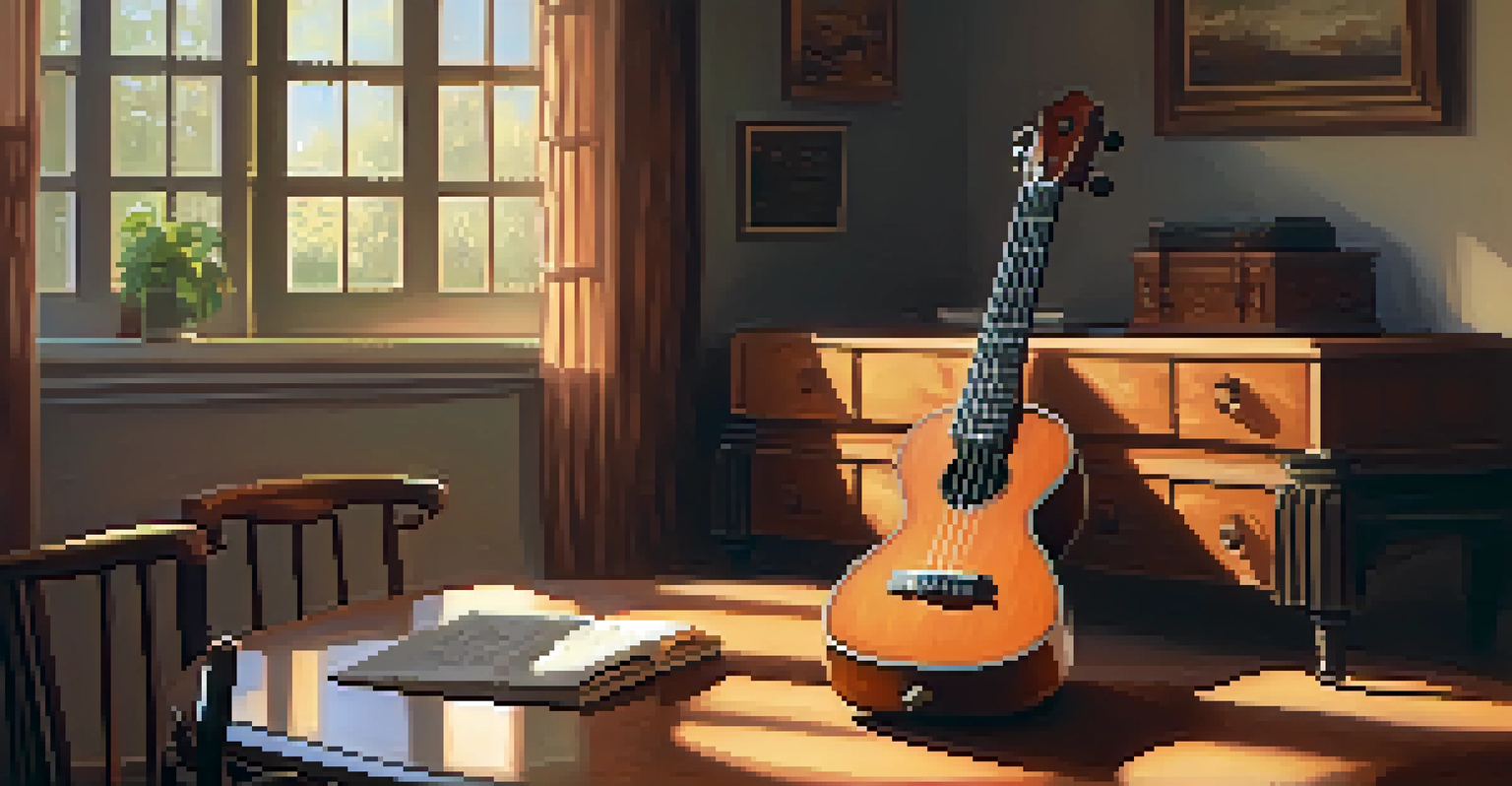Ukulele and Violin: Crafting Unique Melodic Interactions

The Magic of Melodies: Ukulele Meets Violin
When you think of the ukulele, images of sunny beaches and joyful strumming often come to mind. In contrast, the violin evokes the elegance of classical music and intricate solos. However, when these two instruments come together, they create a unique interplay that can stir deep emotions.
Music is the universal language of mankind.
The ukulele, with its bright and cheerful tones, complements the rich, resonant sounds of the violin beautifully. Together, they can transform a simple melody into something enchanting, adding layers and textures that captivate listeners. This combination allows musicians to explore a wide range of genres, from folk to classical.
Imagine a lively beach party where the ukulele leads with a catchy tune, and suddenly, the violin swoops in, adding a dramatic flair. This blend not only enhances the overall sound but also invites audiences to experience music in a new light. It's this delightful contrast that makes their collaboration so special.
Similarities and Differences in Sound Production
At first glance, the ukulele and violin may seem worlds apart, but they share some fundamental similarities. Both instruments are stringed and produce sound through the vibration of their strings. This shared characteristic allows them to create harmonies that resonate well together.

However, the way they produce sound is where the differences start to shine. The ukulele’s nylon or gut strings are plucked, giving it a bright and percussive quality, while the violin’s strings are bowed to create a smooth, sustained tone. This contrast in playing techniques allows for a rich melodic dialogue.
Unique Blend of Sounds
The combination of the bright ukulele and the rich violin creates a captivating musical dialogue that enhances various genres.
Picture a conversation between two friends: one speaks quickly and cheerfully (the ukulele), while the other shares thoughtful stories (the violin). This dynamic interaction not only keeps the audience engaged but also showcases the strengths of each instrument, creating a balanced musical experience.
Cultural Roots: The Journey of Both Instruments
The ukulele has its roots in Hawaii, where it was developed from Portuguese instruments in the late 19th century. Its light-hearted sound embodies the spirit of island life and has become emblematic of Hawaiian culture. Conversely, the violin has a rich history that spans centuries, originating in Italy and becoming a staple in classical music worldwide.
In music, we find the harmony of the world.
Despite their different origins, both instruments have adapted and evolved through various musical genres. The ukulele has found a home in pop music, while the violin has ventured into genres like jazz and folk. This adaptability speaks to the versatility of both instruments, allowing them to connect with diverse audiences.
As they cross cultural boundaries, the ukulele and violin continue to inspire musicians to blend styles and create something entirely new. Their unique histories enrich their collaboration, making every performance a celebration of musical diversity.
Exploring Genres: Fusion of Styles in Music
One of the most exciting aspects of the ukulele and violin duo is their ability to explore various genres. From folk and bluegrass to pop and classical, they can seamlessly transition between styles while maintaining their unique identities. This flexibility allows for innovative compositions that keep listeners on their toes.
For example, in a folk arrangement, the ukulele might provide a rhythmic foundation, while the violin embellishes with melodic flourishes. In a pop song, the violin could take the lead, with the ukulele providing catchy hooks in the background. This interplay creates a captivating soundscape that engages listeners.
Cultural and Historical Roots
The ukulele and violin, despite their different origins, have evolved to connect with diverse audiences across multiple music styles.
This genre-blending not only showcases the musicians' creativity but also encourages collaboration among artists from different backgrounds. When ukulele and violin players come together, the result is often a delightful fusion that can redefine musical boundaries.
Techniques for Harmonizing: Playing Together
To create a harmonious blend, musicians need to understand how each instrument complements the other. One effective technique is to establish a solid rhythmic foundation with the ukulele, allowing the violin to explore melodic variations. This approach allows both instruments to shine while contributing to the overall sound.
Another technique is to use call-and-response patterns, where one instrument plays a phrase, and the other answers. This playful exchange can add depth and excitement to a performance, keeping the audience engaged. It’s like a musical game that highlights the strengths of both instruments.
Ultimately, successful harmonizing boils down to listening and adjusting to each other's sounds. Musicians must find a balance between leading and supporting, ensuring that both the ukulele and violin are equally represented in the performance.
Famous Collaborations: Inspiring Duos
Throughout music history, there have been notable collaborations that highlight the synergy between the ukulele and violin. One such example is the work of contemporary artists who blend these instruments in innovative ways, creating fresh sounds that resonate with audiences. Their collaborative spirit showcases the potential for creative expression.
These artists often draw inspiration from each other’s unique styles, resulting in compositions that are both engaging and memorable. By experimenting with different techniques and musical genres, they push the boundaries of what can be achieved with these instruments. This collaborative approach sparks new ideas and inspires budding musicians.
Harmonizing Techniques
Successful collaborations between ukulele and violin musicians rely on understanding how to complement each other's strengths through rhythmic foundations and call-and-response patterns.
Listening to these dynamic duos can open your ears to the myriad possibilities of combining the ukulele and violin. It’s a reminder that music knows no bounds, and when artists come together, they can create something truly magical.
The Future of Ukulele and Violin Interactions
As music continues to evolve, the future of ukulele and violin interactions looks promising. With technology advancing, musicians now have access to a vast array of tools and platforms for collaboration. This opens the door for even more innovative compositions and performances that blend these two beloved instruments.
Additionally, the growing popularity of both instruments in various music scenes encourages exploration and experimentation. Emerging artists are likely to experiment with different styles and genres, leading to exciting new sounds. This trend not only revitalizes traditional forms but also inspires future generations of musicians.

As we look ahead, the fusion of the ukulele and violin offers endless possibilities. Whether through live performances, recorded music, or online collaborations, the melodic interactions between these instruments are bound to captivate audiences for years to come.